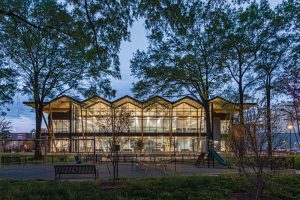The DC Southwest Library is a beautiful, natural, and functional aesthetic solution for the community’s new neighborhood library. The Library elegantly addresses its unique site and connection to the adjacent park. It showcases the world’s first self-supporting timber folded plate roof, using Dowel Laminated Timber (DLT). This, along with other crucial sustainability protocols that influenced the design and construction of the structure, contributed to the LEED Platinum accreditation bestowed on the Library.
The new library was designed as a “low-carbon” heavy timber structural system composed of exposed wood columns, beams, and dowel-laminated floors and roof panels. The library is the first building in the Washington, D.C. area to use this unique mass timber system, setting it apart within the neighborhood and the city.

History
DC Southwest Library honors the Mid-Century Modern architecture and mass timber construction for which this neighborhood is known. The design drew inspiration from another community landmark, the nearby Arena Stage. The exposed timber and its resulting form, along with the textured charcoal brick façade, make the building a memorable and unique addition to the District and neighborhood architecture. The crinkle folded plate bears similarities to historical cast-in-place concrete roof outlines of the 1950s but without the burden of framework and with a nod towards modern connection technology and low-carbon materials. The result is a series of dowel-laminated wood panels that create a unique building massing and a memorable space within.
Challenges
The entire library superstructure is mass timber, with glulam beams and columns and DLT floor and roof slabs. The city building officials needed to be introduced to and educated about this new form of construction before acceptance.
This crinkled roof presented engineering challenges in how it would be detailed, fabricated, installed, and erected. Connection detailing, prefabrication, the assembly jig, and erection planning were keys to its speed of erection and successful installation. The unique shape of the long-span folded plate roofs created a challenge for the structural engineering and construction of these complex elements. The use of dowel laminated timber in a folded-plate structure was a world first. It required complex nonlinear finite element analysis to predict the folded plate’s stresses and structural behavior.
Structural engineering utilized Rhino, hsbCAD, and Revit for the design, engineering, fabrication, and production of the glulam beams, columns, DLT panels, and steel plate connections. The rest of the design team worked inside these models to ensure all elements of the structure were coordinated well. By the time fabrication began, the structural model was highly detailed.
Building Information Modeling
Building Information Modeling (BIM) allows for a 3-D fabrication model with a high level of detail to be used by both designers and constructors – the onsite team used it extensively. Also, BIM allows proactive clash detection and penetration coordination amongst all trades, which is particularly important in a prefabricated, highly exposed timber structure. The BIM model drove the manufacturing of Glulam, DLT, and steel and produced detailed piece shop drawings for each element. Small chamfers were added to the edges of the half modules fabricated in the shop to ensure the elements remained within legal width limits for trucking cross-continent.
Fabrication
The folded plates consisted of DLT panels sheathed in glued plywood to create the necessary diaphragm stiffness. The plywood was in turn fastened and glued in the StructureCraft shop to the folded plate glulam chords at the ridge and trough. For shipping, the chords were split in half, and full folded plate “trusses” were assembled, along with tension rods connecting the four trough corners, to allow the erection of each 65-foot-long x 20-foot-wide folded plate structure on site.
Erection
The erection of the timber structure was rapid, taking a small crew of timber specialists only a matter of weeks to erect the glulam beams and columns, DLT floor slabs, and all sections of the DLT folded plate roof. Because of the extensive prefabrication, all the complex work was done off-site, and elements were shipped ready to “click into place.”
From initial form and design to engineering, prefabrication, and installation, the entire team came together around this complex challenge and delivered successfully on the unique architectural form.■
